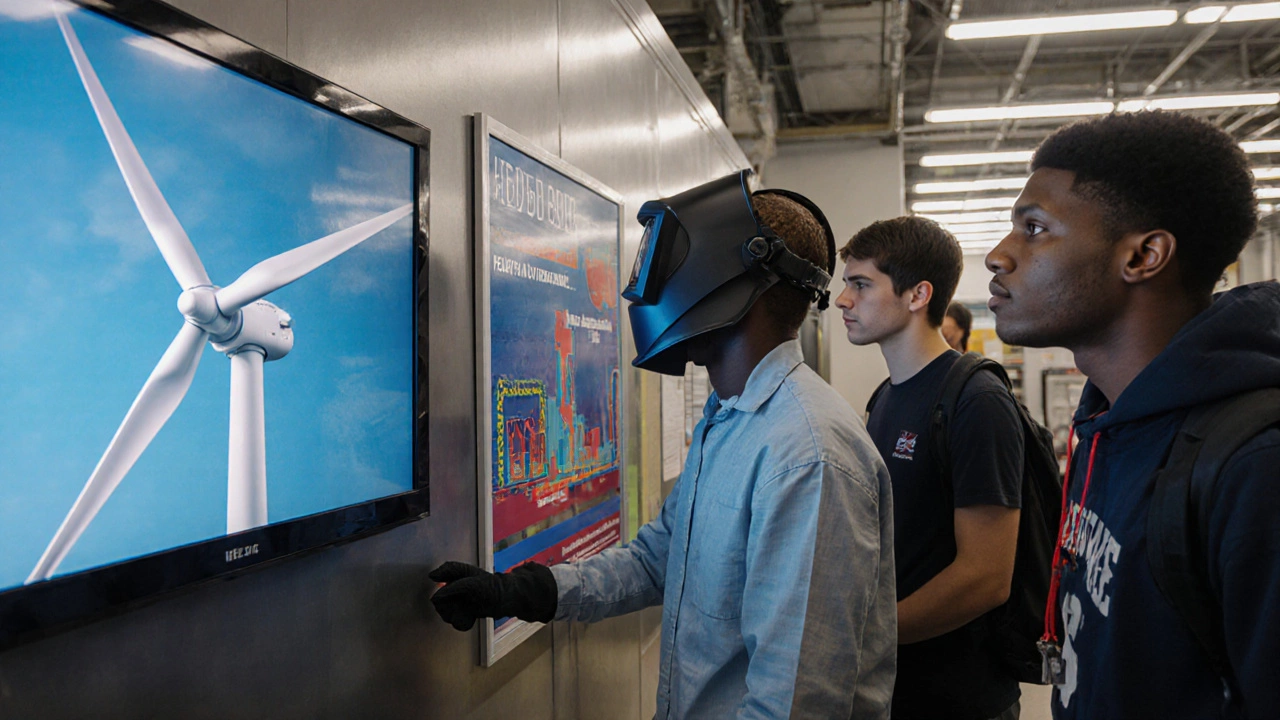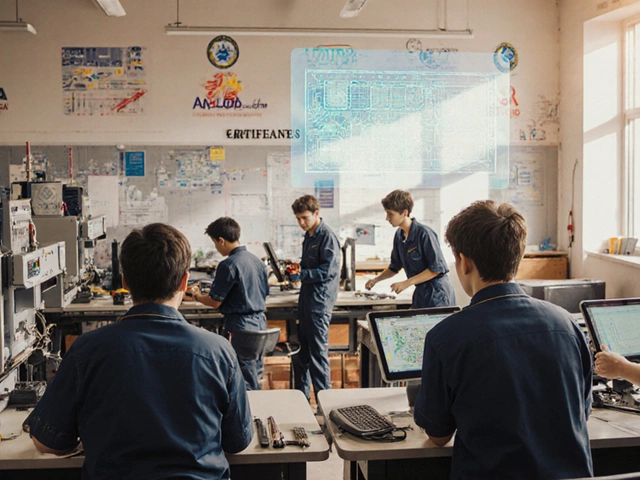
CTE vs College Cost Calculator
Compare Your Options
Calculate the total cost and time investment for CTE versus traditional college paths. See how CTE programs can help you earn a good living without significant debt.
Traditional College
Career and Technical Education (CTE)
Your Results
Career and Technical Education (CTE) saves you and gets you to your first job faster.
Back in the day, if you heard someone say "vocational education," you probably pictured a high school shop class-woodworking, auto repair, maybe sewing. That image isn’t wrong, but it’s outdated. Today, vocational education doesn’t look like what your parents or grandparents knew. It’s not just about fixing cars or typing on a typewriter. It’s about building careers in robotics, cybersecurity, medical coding, renewable energy systems, and even esports management.
It’s Now Called Career and Technical Education (CTE)
The term "vocational education" has been quietly replaced by Career and Technical Education, or CTE. This isn’t just a rename-it’s a full rebrand. The shift happened over the last 15 years, driven by employers, educators, and policymakers who wanted to shake off the old stigma. "Vocational" sounded like a second-choice path. "Career and Technical"? That sounds like a direct route to a good job with real pay.
CTE isn’t just for high schoolers anymore. It spans middle school, high school, community colleges, adult learning centers, and even employer-run training programs. In 2025, over 14 million students in the U.S. are enrolled in CTE programs. That’s nearly half of all high school students. And it’s not just happening in the U.S. Countries like Germany, Canada, and Australia have had similar shifts, using terms like "dual education" or "skills-based training."
What’s Different About CTE Today?
Modern CTE programs are built around industry needs, not just classroom theory. Here’s what sets them apart from old-school vocational training:
- Industry certifications are built into the curriculum. Students graduate with credentials like CompTIA A+, OSHA 10, Certified Nursing Assistant (CNA), or AWS Cloud Practitioner-not just a diploma.
- Work-based learning is standard. That means internships, apprenticeships, job shadowing, and on-the-job training with local employers. Some programs even pay students while they learn.
- Pathways, not dead ends. CTE isn’t a one-way street to a low-wage job. Many students use CTE as a stepping stone to associate degrees, bachelor’s programs, or even advanced certifications. A student who learns HVAC repair in high school can later earn a degree in sustainable energy systems.
- Digital skills are mandatory. Even in trades like plumbing or welding, students now learn how to use digital blueprints, CAD software, inventory apps, and diagnostic tools. Tech literacy isn’t optional-it’s part of the job.
Take the example of a student in Ohio who took a CTE program in medical coding. By senior year, they passed the CPC certification exam (Certified Professional Coder), got hired by a local clinic part-time, and enrolled in a community college health informatics program. That’s not vocational education-it’s a career launchpad.
Why the Name Changed
The old term "vocational" carried baggage. It was often tied to low expectations, special education tracks, or "for kids who aren’t college material." That wasn’t fair-and it wasn’t true. Studies from the Association for Career and Technical Education show that CTE students have higher graduation rates than their non-CTE peers. They’re also more likely to be employed within six months of graduation.
Employers pushed for the change. Companies like Siemens, Lockheed Martin, and Kaiser Permanente started partnering with schools to design programs that actually filled their open roles. They didn’t want to hire people who "knew how to use a wrench." They wanted people who could use a wrench and a tablet to read digital schematics, follow safety protocols, and document work orders.
Parents started noticing too. When your child comes home talking about earning a Microsoft Azure credential before graduation, you don’t think "vocational." You think "smart career move."

What CTE Programs Look Like in 2025
Today’s CTE programs are diverse, tech-forward, and aligned with high-demand fields. Here are some real examples:
- Advanced Manufacturing: Students learn CNC machining, robotics programming, and quality control using industry-standard equipment.
- Health Informatics: Training in electronic health records, medical billing, HIPAA compliance, and data entry for clinics and hospitals.
- Cybersecurity Fundamentals: High schoolers learn network defense, phishing detection, and basic penetration testing-often with certifications from CompTIA or Cisco.
- Sustainable Energy Technology: Solar panel installation, wind turbine maintenance, and energy auditing programs are now common in rural and urban schools alike.
- Logistics and Supply Chain: Students use warehouse management software, learn inventory tracking systems, and train on forklifts and automated sorting tech.
- Digital Media and Design: Video editing, motion graphics, web design, and social media marketing are now part of CTE tracks in many districts.
These aren’t electives. They’re full credit-bearing pathways that can lead directly to employment or further education. In fact, 72% of CTE concentrators in 2024 went on to college or advanced training within two years, according to the National Center for Education Statistics.
How to Find a CTE Program Near You
If you’re looking for a CTE program, here’s how to start:
- Check your local public high school’s website. Look for a "Career and Technical Education" or "CTE Pathways" section.
- Search for your state’s Department of Education CTE directory. Most states list approved programs and partner employers.
- Contact your local community college. Many offer dual enrollment for high school students or adult CTE certificates.
- Look for industry partnerships. Programs tied to big employers (like Amazon, GE, or local hospitals) often have better equipment and job placement.
- Ask about certifications. The best programs include at least one industry-recognized credential you can earn before graduation.
Don’t assume CTE is only for teens. Adult learners can enroll in CTE programs through community colleges, workforce development boards, or nonprofit training centers. Many are free or low-cost, especially if you’re unemployed or underemployed.

CTE vs. Traditional College: What’s the Real Difference?
Some people still think CTE means "skip college." That’s not true. The real difference is timing and focus.
Traditional college often asks you to spend two years taking general education classes-history, math, literature-before you even touch your major. CTE skips the fluff. You start learning job-specific skills on day one. You graduate with work experience, a certification, and sometimes even a job offer.
And the cost? A two-year CTE certificate at a community college often costs under $5,000. A four-year degree? That’s $50,000 or more. Many CTE graduates enter the workforce debt-free. That’s not a fallback-it’s a strategy.
Here’s the kicker: 68% of jobs in the U.S. now require some form of postsecondary training-but not necessarily a bachelor’s degree. That includes roles like nuclear medicine technologists, wind turbine technicians, and cybersecurity analysts. All of these can be reached through CTE.
What’s Next for CTE?
CTE is growing fast. In 2025, the U.S. Department of Education is funding new programs in AI-assisted manufacturing, green hydrogen technology, and mental health peer support. States are also rolling out digital badges that students can carry on LinkedIn, showing employers exactly what they can do.
The future of CTE isn’t just about jobs-it’s about dignity. It’s about giving people a clear, respected, and well-paid path to build a life without needing to take on $40,000 in debt. It’s about recognizing that not everyone needs to go to college to succeed-and that’s okay.
So if you hear someone say "vocational education," you can correct them gently. It’s not vocational anymore. It’s Career and Technical Education. And it’s one of the most powerful tools for building a future that actually works.
Is vocational education the same as CTE?
CTE is the modern name for what used to be called vocational education. While the core idea-training for specific jobs-is the same, CTE is broader, more respected, and more aligned with today’s workforce. It includes digital skills, certifications, and pathways to college, which older vocational programs often didn’t.
Can you go to college after CTE?
Absolutely. In fact, most CTE programs are designed to lead into college. Many community colleges accept CTE credits as transferable. Students who earn certifications like CompTIA or CNA can often skip introductory courses. Over 70% of CTE students go on to further education within two years of graduating high school.
Are CTE programs only for high school students?
No. CTE programs exist for adults too. Community colleges, workforce development agencies, and nonprofit training centers offer CTE certificates in fields like medical assisting, welding, IT support, and logistics. Many are free or low-cost for unemployed or underemployed adults.
Do employers value CTE credentials?
Yes, more than ever. Companies like Amazon, Boeing, and Kaiser Permanente actively recruit from CTE programs because they know graduates are job-ready. Industry certifications (like OSHA, AWS, or CompTIA) are often more valuable to employers than general college degrees for technical roles.
What’s the difference between CTE and apprenticeships?
Apprenticeships are a type of CTE. All apprenticeships are CTE, but not all CTE is apprenticeship-based. Apprenticeships combine paid on-the-job training with classroom instruction and usually last 1-4 years. CTE includes high school courses, community college certificates, and bootcamps too.




